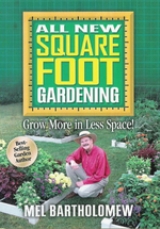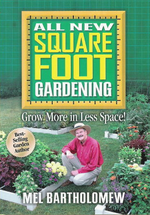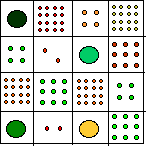
Square foot gardening
Encyclopedia

Rodale Press
Rodale, Inc., is an American publisher of health and wellness magazines, books, and digital properties. Rodale is headquartered in Emmaus, Pennsylvania and also maintains a satellite office in New York City, on Third Avenue....
book and subsequent PBS television series. A full-length companion DVD, Square Foot Gardening (2010), was recently released in collaboration with Patti Moreno
Patti moreno
Patti Moreno, born in New York City, is an independent film producer and television personality best known for her work as Garden Girl on the hit web video series Garden Girl TV. Living and working in Boston, Patti publishes the hit website and e-newsletter , and is in the process of writing a book...
the Garden Girl. The practice combines concepts from other organic gardening
Organic horticulture
Organic horticulture is the science and art of growing fruits, vegetables, flowers, or ornamental plants by following the essential principles of organic agriculture in soil building and conservation, pest management, and heirloom variety preservation....
methods, including a strong focus on compost
Compost
Compost is organic matter that has been decomposed and recycled as a fertilizer and soil amendment. Compost is a key ingredient in organic farming. At its most essential, the process of composting requires simply piling up waste outdoors and waiting for the materials to break down from anywhere...
, closely planted raised bed
Raised bed gardening
Raised bed gardening is a form of gardening in which the soil is formed in 3–4 foot wide beds, which can be of any length or shape. The soil is raised above the surrounding soil , sometimes enclosed by a frame generally made of wood, rock, or concrete blocks, and enriched with compost...
s and biointensive
Biointensive
The biointensive method is an organic agricultural system which focuses on maximum yields from the minimum area of land, while simultaneously improving the soil. The goal of the method is long term sustainability on a closed system basis...
attention to a small, clearly defined area. Proponents claim that the method is particularly well-suited for areas with poor soil, beginning gardeners or as adaptive recreation
Adaptive recreation
Adaptive Recreation is a concept whereby people with disabilities are given the opportunity to participate in recreational activities. Through the use of activity modifications and assistive technology, athletes or participants in sports or other recreational pursuits are able to play alongside...
for those with disabilities
Disability
A disability may be physical, cognitive, mental, sensory, emotional, developmental or some combination of these.Many people would rather be referred to as a person with a disability instead of handicapped...
.
Basic Method

Tomato
The word "tomato" may refer to the plant or the edible, typically red, fruit which it bears. Originating in South America, the tomato was spread around the world following the Spanish colonization of the Americas, and its many varieties are now widely grown, often in greenhouses in cooler...
plant might take a full square, as might herbs such as oregano
Oregano
Oregano – scientifically named Origanum vulgare by Carolus Linnaeus – is a common species of Origanum, a genus of the mint family . It is native to warm-temperate western and southwestern Eurasia and the Mediterranean region.Oregano is a perennial herb, growing from 20–80 cm tall,...
, basil
Basil
Basil, or Sweet Basil, is a common name for the culinary herb Ocimum basilicum , of the family Lamiaceae , sometimes known as Saint Joseph's Wort in some English-speaking countries....
or mint, while most strawberry
Strawberry
Fragaria is a genus of flowering plants in the rose family, Rosaceae, commonly known as strawberries for their edible fruits. Although it is commonly thought that strawberries get their name from straw being used as a mulch in cultivating the plants, the etymology of the word is uncertain. There...
plants could be planted four per square, with up to sixteen radish
Radish
The radish is an edible root vegetable of the Brassicaceae family that was domesticated in Europe, in pre-Roman times. They are grown and consumed throughout the world. Radishes have numerous varieties, varying in size, color and duration of required cultivation time...
es per square. Tall or climbing plants such as maize
Maize
Maize known in many English-speaking countries as corn or mielie/mealie, is a grain domesticated by indigenous peoples in Mesoamerica in prehistoric times. The leafy stalk produces ears which contain seeds called kernels. Though technically a grain, maize kernels are used in cooking as a vegetable...
or pole beans
Common bean
Phaseolus vulgaris, the common bean, is an herbaceous annual plant domesticated independently in ancient Mesoamerica and the Andes, and now grown worldwide for its edible bean, popular both dry and as a green bean. The leaf is occasionally used as a leaf vegetable, and the straw is used for fodder...
might be planted in a northern row (south in the southern hemisphere) so as not to shade other plants, and supported with lattice or netting.
The logic behind using smaller beds is that they are easily adapted, and the gardener can easily reach the entire area, without stepping on and compacting the soil. In the second edition, Bartholomew suggests using a "weed barrier" beneath the box, and filling it completely with "Mel's mix," a combination by volume of one third of decayed Sphagnum
Sphagnum
Sphagnum is a genus of between 151 and 350 species of mosses commonly called peat moss, due to its prevalence in peat bogs and mires. A distinction is made between sphagnum moss, the live moss growing on top of a peat bog on one hand, and sphagnum peat moss or sphagnum peat on the other, the...
"peat moss", one-third expanded vermiculite
Vermiculite
Vermiculite is a natural mineral that expands with the application of heat. The expansion process is called exfoliation and it is routinely accomplished in purpose-designed commercial furnaces. Vermiculite is formed by weathering or hydrothermal alteration of biotite or phlogopite...
and one-third blended compost
Compost
Compost is organic matter that has been decomposed and recycled as a fertilizer and soil amendment. Compost is a key ingredient in organic farming. At its most essential, the process of composting requires simply piling up waste outdoors and waiting for the materials to break down from anywhere...
. For accessibility
Accessibility
Accessibility is a general term used to describe the degree to which a product, device, service, or environment is available to as many people as possible. Accessibility can be viewed as the "ability to access" and benefit from some system or entity...
, raised boxes may have bottoms to sit like tables at a convenient height, with approximately 6" (15cm) of manufactured soil per square foot.
Rationale
In this method, the garden space is divided into beds that are easily accessed from every side. A 4' x 4', 16 sq ft (1.5 m²) or 120 cm x 120 cm, 1.4 m2 garden is recommended for the first garden, and a path wide enough to comfortably work from should be made on each side of the bed, if possible, or if the bed must be accessed by reaching across it, a narrower one should be used so that no discomfort results from tending the garden. Each of the beds is divided into approximately one square foot units and marked out with sticks, twine, or sturdy slats to ensure that the square foot units remain visible as the garden matures.Different seeds are planted in each square, to ensure a rational amount of each type of crop is grown, and to conserve seeds instead of overplanting, crowding and thinning plants. Common spacing is one plant per square for larger plants (broccoli
Broccoli
Broccoli is a plant in the cabbage family, whose large flower head is used as a vegetable.-General:The word broccoli, from the Italian plural of , refers to "the flowering top of a cabbage"....
, basil
Basil
Basil, or Sweet Basil, is a common name for the culinary herb Ocimum basilicum , of the family Lamiaceae , sometimes known as Saint Joseph's Wort in some English-speaking countries....
, etc.), four plants per square for medium large plants like lettuce
Lettuce
Lettuce is a temperate annual or biennial plant of the daisy family Asteraceae. It is most often grown as a leaf vegetable. It is eaten either raw, notably in salads, sandwiches, hamburgers, tacos, and many other dishes, or cooked, as in Chinese cuisine in which the stem becomes just as important...
, nine plants per square for medium-small plants like spinach
Spinach
Spinach is an edible flowering plant in the family of Amaranthaceae. It is native to central and southwestern Asia. It is an annual plant , which grows to a height of up to 30 cm. Spinach may survive over winter in temperate regions...
, and sixteen per square for small plants such as onions and carrots. Plants that normally take up yards of space as runners, such as squash or cucumbers, are grown vertically on sturdy frames that are hung with netting or string to support the developing crops. Ones that grow deep underground, such as potatoes or carrots, are grown in a square foot section that has foot tall sides and a planting surface above the ground, so that a foot or more of framed soil depth is provided above the garden surface rather than below it.
The beds are weeded and watered from the pathways, so the garden soil
Soil
Soil is a natural body consisting of layers of mineral constituents of variable thicknesses, which differ from the parent materials in their morphological, physical, chemical, and mineralogical characteristics...
is never stepped on or compacted. Because a new soil mixture is used to create the garden, and a few handfuls of compost are added with each harvest to maintain soil fertility over time, the state of the site's underlying soil is irrelevant. This gardening method has been employed successfully in every region, including in deserts, on high arid mountain plateaus, in cramped urban locations, and in areas with polluted or high salinity soils. It is equally useful for growing flowers, vegetables, herbs and some fruits in containers, raised beds, on tabletops or at ground level, in only 4 to 6 inches (152.4 mm) of soil. A few seeds per square foot, the ability to make compost, to water by hand, and to set up the initial garden in a sunny position or where a container, table or platform garden may be moved on wheels to receive light is all that is needed to set up a square foot garden.
Benefits of Square Foot Gardening
- Much less work. Conventional gardening requires heavy tools to loosen the soil, whereas in this method, the soil is never compacted and it remains loose and loamy. Weeding takes only seconds to minutes, due to the light soil, raised beds, and easily accessed plants. Harvests per foot of garden are increased due to the rich soil mixture, well-spaced plants, and lack of weeds produced when following Mel Bartholomew's method.
- Water Savings. The soil mixture that is advised has water-holding capacities, so that the garden needs water less frequently, and in much smaller quantities than when using other gardening methods. Water is also spared by hand-watering directly at the plant roots, so that there is very little waste
and tender young plants and seedlings are preserved. - Very little weeding. One benefit of this close planting is that the vegetables form a living mulchMulchIn agriculture and gardening, is a protective cover placed over the soil to retain moisture, reduce erosion, provide nutrients, and suppress weed growth and seed germination. Mulching in gardens and landscaping mimics the leaf cover that is found on forest floors....
, and shade out many weedWeedA weed in a general sense is a plant that is considered by the user of the term to be a nuisance, and normally applied to unwanted plants in human-controlled settings, especially farm fields and gardens, but also lawns, parks, woods, and other areas. More specifically, the term is often used to...
seeds before they have a chance to germinate. - Pesticide / Herbicide Free. Natural insect repellent methods like companion plantingCompanion plantingCompanion planting is the planting of different crops in proximity , on the theory that they assist each other in nutrient uptake, pest control, pollination, and other factors necessary to increasing crop productivity...
(i.e. planting marigoldTagetesTagetes is a genus of 56 species of annual and perennial mostly herbaceous plants in the sunflower family . The genus is native to North and South America, but some species have become naturalized around the world. One species, T...
s or other naturally pest-repelling plants) become very efficient in a close space and thus, pesticides are not necessary. The large variety of crops in a small space also prevents plant diseases from spreading easily - Accessibility. A plywood bottom can be attached to the bottom of a box, which can then be placed on a tabletop or raised platform for those who wish to garden without bending or squatting, or to make gardening easy for wheelchair, cane or walker users.
- Covers and Cages. Because all beds are small (4'x4' or smaller), making covers or cages to protect plants from pests, cold, or sun is more practical than with larger gardens.
See also
Square foot gardening is especially compatible with:- Raised bed gardeningRaised bed gardeningRaised bed gardening is a form of gardening in which the soil is formed in 3–4 foot wide beds, which can be of any length or shape. The soil is raised above the surrounding soil , sometimes enclosed by a frame generally made of wood, rock, or concrete blocks, and enriched with compost...
- Companion plantingCompanion plantingCompanion planting is the planting of different crops in proximity , on the theory that they assist each other in nutrient uptake, pest control, pollination, and other factors necessary to increasing crop productivity...
- French intensive gardeningFrench intensive gardeningFrench intensive gardening is a method of gardening in which man works with nature to foster healthy, vibrant plants with smaller space and less water than more traditional gardening...
- Organic gardening
Further reading
- Mel Bartholomew Interview An Interview With the Creator of Square Foot Gardening
- Official Site of Square Foot Gardening website of creator Mel Bartholomew, includes info on how to get started, tips and FAQs
- Mel Bartholomew's Official Blog personal blog of creator Mel Bartholomew, includes weekly columns about gardening, humor, changing the world, and history

